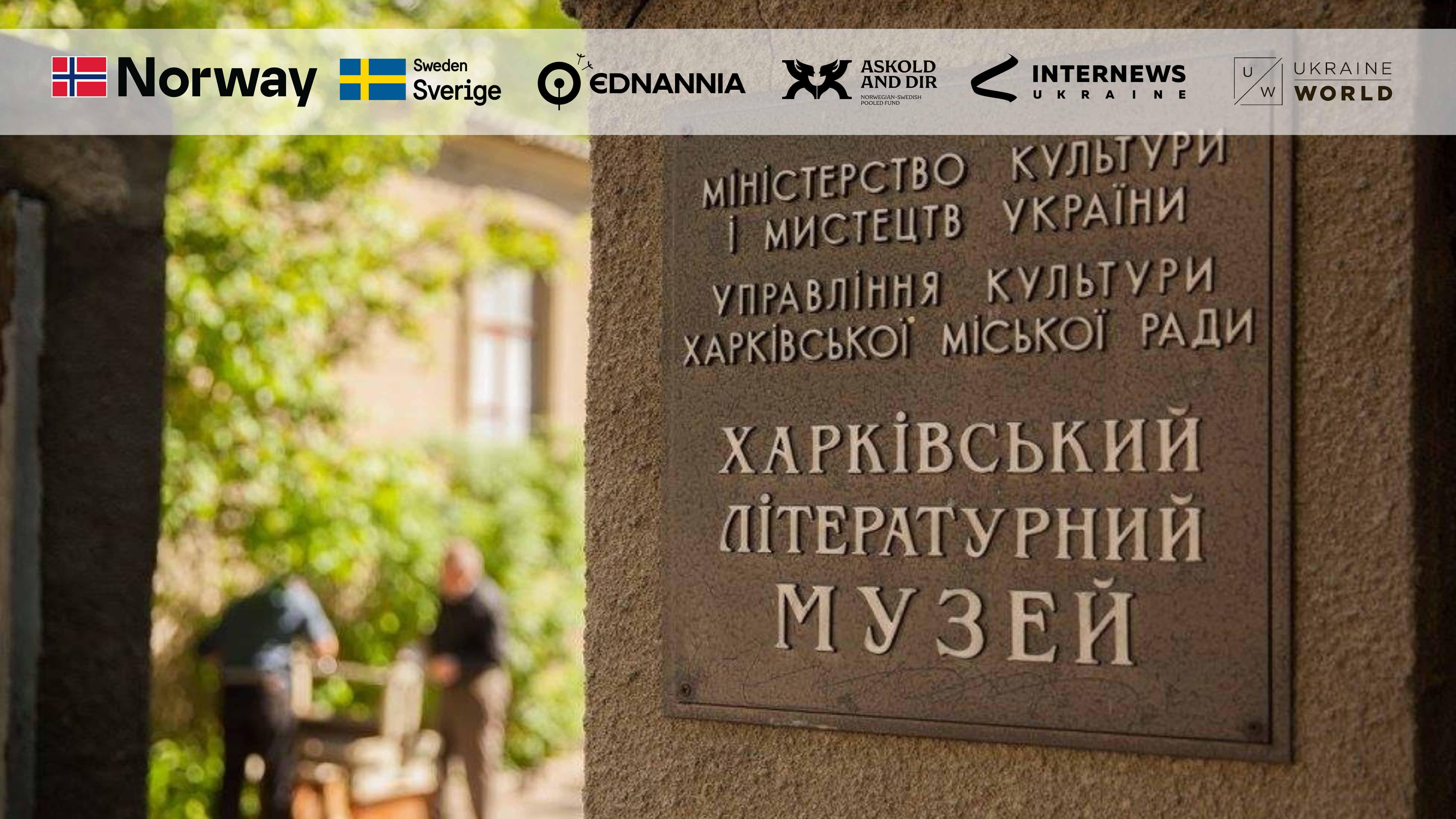
Despite daily shelling threats, Kharkiv — just 30-40 kilometers from the Russian border — keeps its cultural heartbeat. The Kharkiv Literary Museum shows the same resilience: it survived Stalin's repressions and, this March, was damaged by a nearby Russian drone strike.
The LitMuseum isn't just a place for exhibitions. It's a space that thinks, creates, and gathers a steady circle of people around it. It keeps alive the memory of Kharkiv's writers of the 1920s-30s and draws in today's authors, artists, and researchers who carry that line through the war.
The museum team isn't afraid to question what a museum is — not a vault of the past, but a living part of culture.
The Literary Museum of Kharkiv was founded in 1988 in a mansion dating back to the early 20th century, thanks to the efforts of local enthusiasts.
"The museum was established by activists with anti-Soviet sentiments in the final years of the USSR. That's why it was never a tool of propaganda but rather a Ukrainian voice of Kharkiv, responsive to social issues," the museum's website reads.
Throughout its existence, the LitMuseum has reflected the transformations of Ukraine and its literary life, never remaining on the sidelines. Since the beginning of Russia's full-scale invasion, the museum has also engaged in volunteer initiatives to support the Armed Forces of Ukraine.
In this interview with Tetiana Pylypchuk, director of the Literary Museum of Kharkiv, we talk about the remarkable resilience of culture under constant Russian shelling, the new approaches to museum work prompted by the realities of war, and the role museums play across different times.
Tetiana Pylypchuk is a Ukrainian philologist, literary scholar, museum professional, cultural manager, and volunteer. She is the director of the Literary Museum of Kharkiv and a laureate of the Vasyl Stus Prize. She has curated numerous museum projects, including the "Fifth Kharkiv" festival and the Kharkiv Art Residency "Slovo."
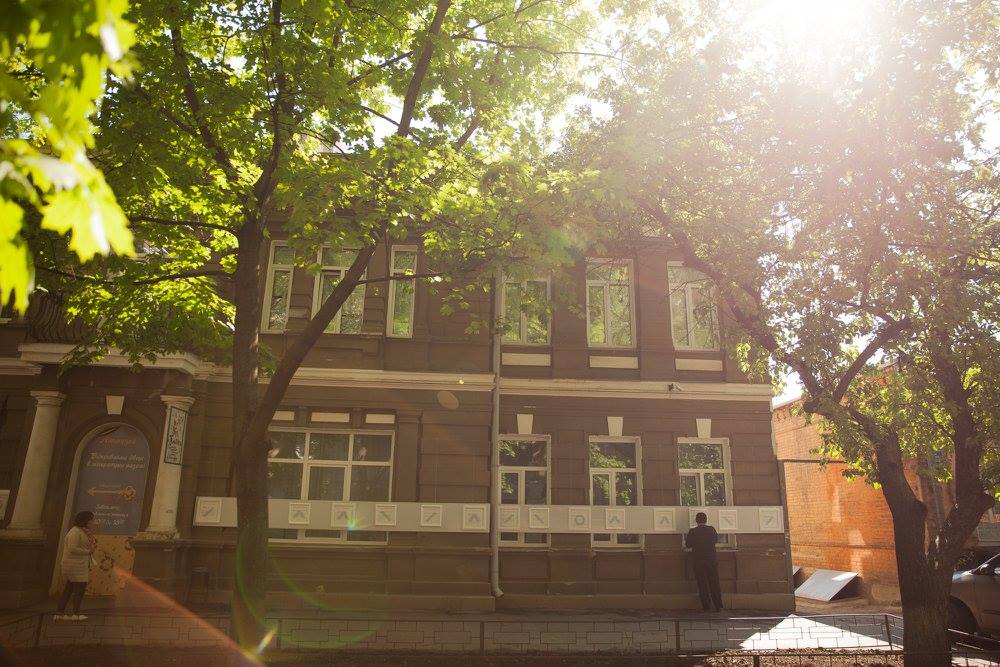
Today, it's not only museums that find themselves in a harsh context — all of us Ukrainians are simply trying to survive. And yet, museums everywhere in the world face a very direct question: why do they exist? Why should society fund and maintain them?
We think about this constantly. A museum gives a person the chance to place their own life within a broader historical context. At times, it may feel like our lives are small and insignificant. But a museum shows us there is no such thing as a "small" or a "big" life. Every life is always part of a larger story — one that began long before us and, God willing, will not end with us. That sense of belonging to something greater and more important is one of the museum's key roles.
We tried to express this idea in the exhibition Imenem Mista (In the Name of the City), where we explored the notion that memory is a construct — one that often says more about us than it does about the past. A museum doesn't build that memory itself; it creates the conditions for everyone to participate in it.
Today, it's crucial to package our experiences into memory in such a way that they remain vivid and continue to speak to those who did not live through them. This helps prevent history from breaking apart into isolated storylines and allows us to live in a more harmonious society.
A museum cannot exist separately from its community. We can't pretend that war or tragedy is happening "out there," while we quietly wait it out in our shelters and then return when it's safe. What would we return with, and to whom would we matter then? A museum has to resonate with the life of the society around it — from the immediate community formed around the museum itself to wider circles.
We see that those who come to the museum can influence society across different communities. That's why I truly hope we have moved beyond thinking in terms of "majority/minority," or reducing democracy to simply the rule of the majority. Instead, we should recognize society as made up of different groups — all of which are ours. These groups may come together situationally or on deeper foundations. But I don't see some kind of monolithic majority we should orient ourselves toward. I believe our focus should be on connecting diverse experiences — and on ensuring that everyone has the right to live out these different experiences.
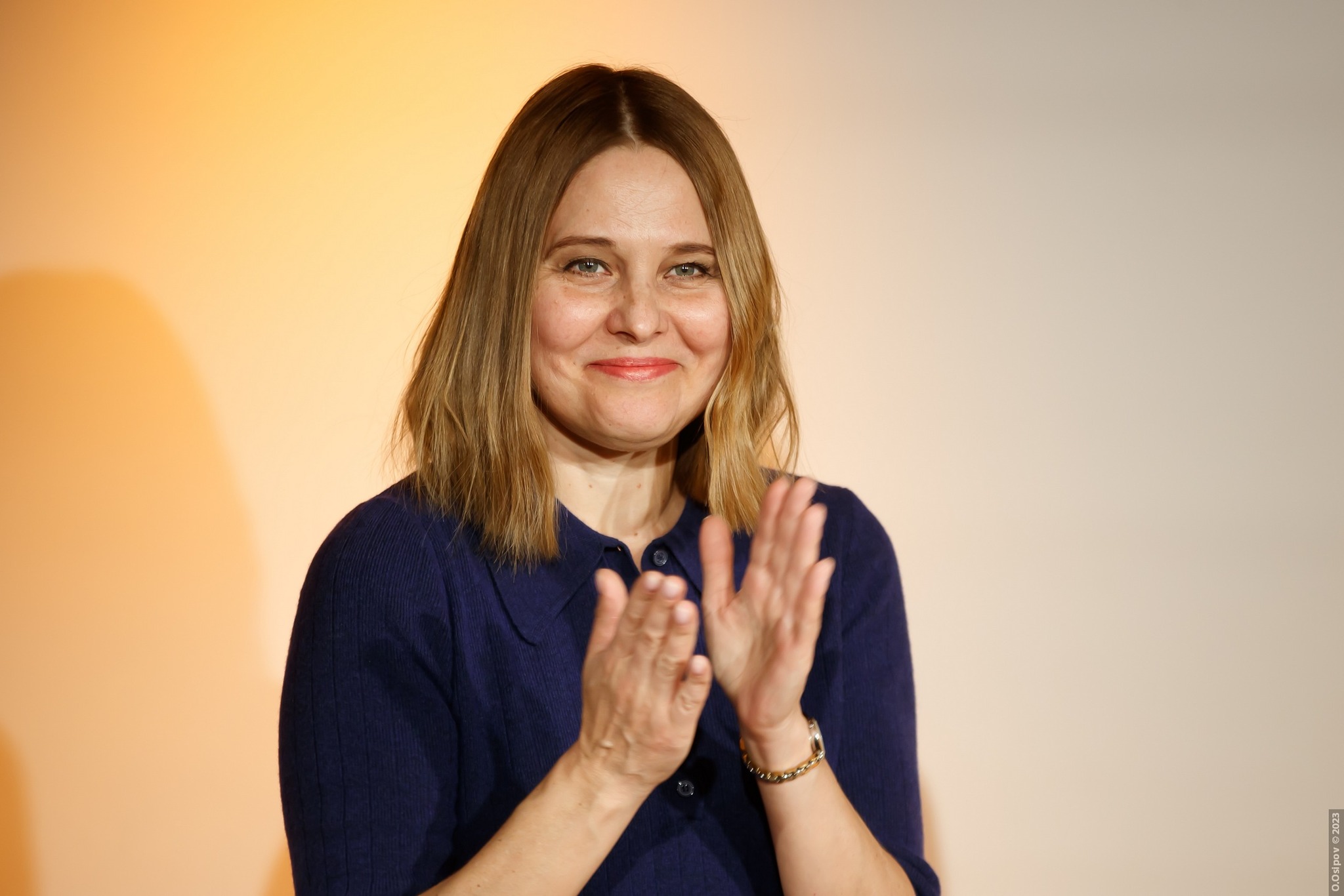
What drew me to the LitMuseum was its atmosphere of freedom — a space where you could express yourself and freely bring your ideas to life.
The museum has always stood with society, taking part in many of its revolutions. The values defended during the Revolution on Granite, the Orange Revolution, and the Revolution of Dignity have been essential for us.
Since 2014, it became clear that the museum could not ignore the war, could not refrain from volunteering, and could not stand aside from processes vital to society. We have tried to identify sensitive, painful issues and to contribute to overcoming them.
Much of this has related to the question of bilingualism and Russian-speaking Ukrainians. This is a complex issue. The museum does not act as an institution that forbids others from having their own memory. We approach it very carefully and respectfully, no matter the language in which it is expressed — whether it includes Pushkin or not. Our approach has always been people-centered.
After 2022, we realized that the museum's resources are limited. That's why we decided to use them as effectively as possible in the situation we found ourselves in.
We have become far more flexible. We plan our activities, but that doesn't mean that a plan approved at the beginning of the year will remain unchanged. We must respond to events and react quickly. Our resources — the team, the people, the funds we manage to gather — we direct them in ways that will help both the victory and the society we will live in afterward.
We constantly ask ourselves what is worth investing in today. We've learned to be flexible, but at the same time, we don't step back from our principles.
The workload has increased significantly. And I'll be honest: the fewer we Ukrainians become, the more work each of us has to do.
As for the fundamental values that the museum is built on, they haven't changed. I believe they remain relevant to the direction in which the democratic world is moving. But of course, the principles of how we work have changed. In this new context, we operate differently — just as the entire country does.
When a strike hit near the museum, our windows were blown out and part of the ceiling collapsed. Fortunately, no one was killed and the damage wasn't critical. Still, it was a serious challenge.
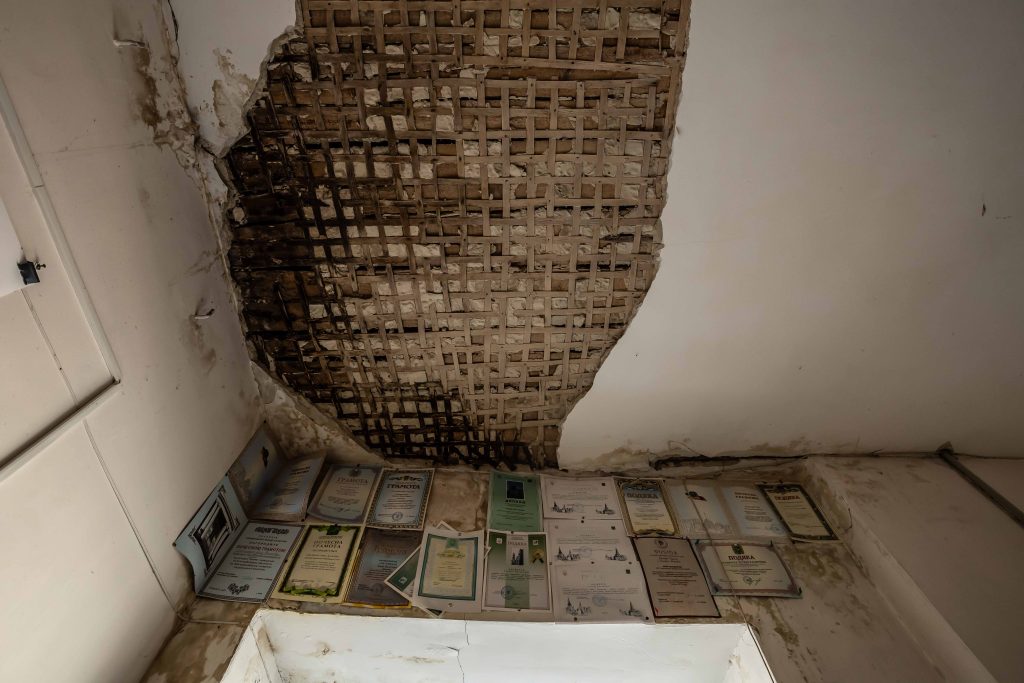
Today, the world — especially organizations that are not ready to fund military needs but still want to support Ukraine — tends to focus on the social sphere and on culture. Everyone likes to support culture. That's why our museum has adopted this principle: we turn less to those covering military needs and instead seek funding from people and organizations willing to support cultural projects specifically. If someone says, "We want to support the museum," we ask, "Are you ready to donate for drones?" If the answer is no, then we accept their help for the museum.
Right after the strike, we saw how many people were ready to support us. Some helped clean up, some brought pastries or coffee, others brought trash bags. We saw just how important the museum is. I think that was the real recognition of our work.
Later, a number of foundations reached out, offering to help repair the museum. The building was already "tired," and we had been planning a major renovation back in 2022, but it never happened. Now we've decided to use this opportunity: the repairs won't be large-scale, more like "minimal," but we want to make the museum space as comfortable as possible for both the team and visitors. Hopefully, we'll finish by next year.
It's important to understand that a museum doesn't work for a department or a Ministry of Culture — it works for society.
That perspective changes a great deal. We don't do things "for" visitors or partners — we do them together. That's why we have so many joint and collaborative projects.
Another crucial perspective: we shouldn't think in terms of formal staff structures — that here is the museum, and beyond that is not the museum. That kind of thinking has helped us build a strong community of people who feel they are part of the museum. We treat partnership with great care: it's important to us that our partners feel good working with us, and that they benefit from our joint projects.
Right now, we all need to be much more effective than we were in peacetime. This is a matter of survival. So whenever we launch an initiative with partners, we always think about how to make sure their results are as strong as possible.
For us, this vision of partnership took shape in the project Misto-Namysto within the exhibition Imenem Mista. It was our way of reimagining what kind of city we want to live in — and what bonds can create a true sense of happiness here.
Right now, we are working without the museum's collection. It has been secured from the war in a different place. And that, in turn, has opened up many possibilities.
We've always said that a collection is not just about objects — it's about experience, memory, and meaning. But when we had the objects at hand, we actively used them and could hardly imagine how those meanings could be communicated without them. Today, we've found ourselves in a situation that revealed: there are far more channels of communication, and they work even without museum artifacts. Now we can develop and use them further.
In some ways, this experience has even challenged the very idea of preservation. For museum professionals, "to preserve" has traditionally meant having a properly equipped storage facility where untouchable objects are carefully watched over so they remain in the exact same condition in which they entered the museum. But during our Imenem Mista initiative, in one of the discussions, Yevhenii Stasinevych said something that completely shifted our perspective: "What is best preserved is not what is most carefully guarded, but what is used by as many people as possible."
This redefines the notion of preservation in a museum. It's not only about physical care for the objects, but above all about bringing the meanings they carry into public life. That way, people can truly feel their value. Otherwise, they risk being seen as just old things — "fit for a museum."
We want to change that perception. Yes, these things may be old physically, but in terms of relevance, they can be new and extremely valuable. The key is to learn how to make them "speak" in ways that give us the richest possible meanings.
After the beginning of the full-scale invasion, the bonds among the city's residents grew stronger.
Those who stayed behind, especially in 2022, were forced to unite. How did it work? Once again, it was Misto Namysto — our horizontal connections. Most of the proactive people who helped hold the city together supported our defense forces and, I hope, became a worthy rear for those defending Kharkiv and for those who could not hold themselves together.
No one waited for orders from the administration. There were no instructions, no leadership — we didn't even know if it existed in the city or the Oblast. Obviously, something was being done somewhere, but this self-organization was astonishing.
For example, there was a sudden need to feed 70 cadets — immediately, someone appeared who knew where to get the food. At that time, supermarkets in Kharkiv weren't working. At the same time, another person offered funding, someone else provided a car, and another knew which café could cook meals from those products. And all of this happened within just a few minutes. This shows the will to keep the city alive — the desire to live in the city.
These bonds remain strong to this day. Recently, we launched a wonderful project — Blahovishchenskyi Kurin.
About half a year ago, Mykyta Virchenko, the founder of Trypichchia — a very popular place in Kharkiv, a café-restaurant of reimagined Ukrainian cuisine — came to the museum.
We started working together with Mykyta and realized that museums and gastronomy complement each other perfectly. This is a remarkable charitable café: 100% of its net profit goes to charity. Usually, businesses create civic movements to support important initiatives or promote their values. But here, a volunteer organization, a restaurant, and a museum came together to open a business that supports causes we all care deeply about.
We are constantly engaging with international audiences. Right now, we have the exhibition Antitext, an idea that emerged back in 2022. We created it and presented it in spring 2023, translated it into German, and now it is traveling across Germany.
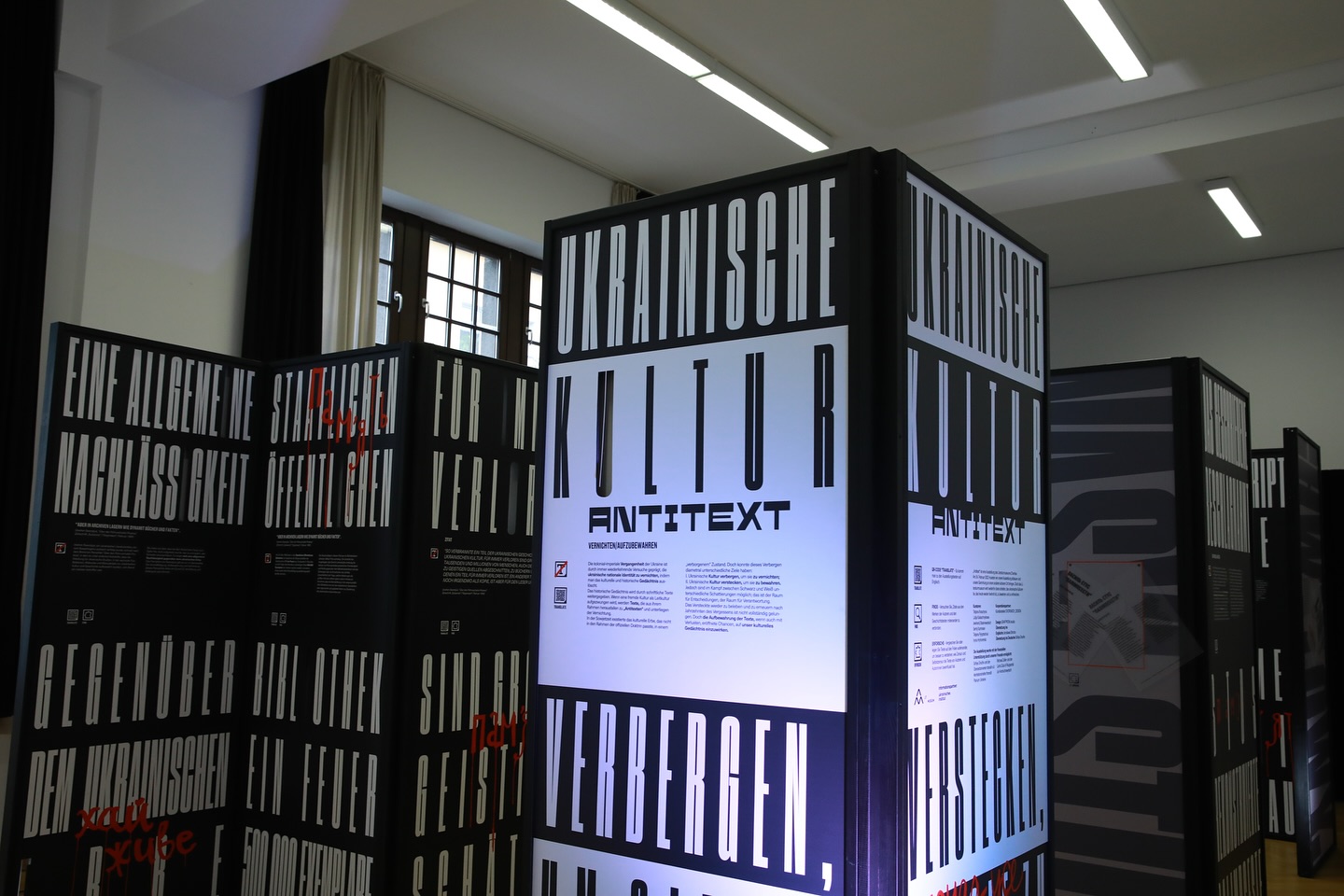
Antitext explores how absence shapes us. When we packed up our collection, we saw empty walls and display cases, which made us reflect on our museum objects — works by Mykola Khvylovyi, materials from the 1920s, resistance movements, and the Sixties generation — materials that were censored or outright banned in the Soviet Union. For a long time, these items remained hidden and did not serve society.
This brings us back to the question: how does absence shape our thinking? Texts from the 1920s only reentered circulation in the 1990s, when several generations of our parents had no chance to read or engage with them. How should we now relate to century-old texts that had dropped out of the humanistic discourse but have returned?
The exhibition raises questions about how these "returns" affect us: the joyful moments when texts can be rediscovered, and the painful ones when we know they exist but have never read them. There are also ambivalent cases: some texts reached us through denunciations or special storage — "prisons for books." We are grateful the information survived, yet we reflect on the paths by which it came to us.
The exhibition was funded by German partners in 2022: they wanted to support the museum but could not directly aid the army. Since then, Antitext has already been shown in Berlin, Cologne, and Graz at a Slavic Studies conference, and from spring 2024, it was exhibited at Humboldt University and the Leipzig National Library's Book Museum; it is currently on display in Frankfurt (Oder) at Viadrina. Upcoming locations include Tübingen, Greifswald, and other universities.
This work is very important for us. For example, Humboldt University has already suggested research on Ukrainian texts from the 1920s, which for us signals a gradual shift from Russian studies to Ukrainian studies.
We are preparing relevant proposals and hope that Viadrina will also include the 1920s in its research focus.
At the same time, we are running a dialogue platform called City on the Line in partnership with the University of Pennsylvania, supported by the Renaissance Foundation. Our partners include the Kharkiv Media Hub and the Center for Interethnic Relations in Eastern Europe, providing academic and media perspectives. The Media Hub produces media content based on discussions, while the museum oversees the concept and organization. City on the Line attempts to connect theory and practice, exploring how contemporary theories help us engage with the realities of our city.
Topics already addressed on the platform include "our others," the corporeality of war, and decolonization. We are currently producing media content: full recordings of discussions are already available, and shorter formats will follow. At the end of September, we will organize a conversation on cultural heritage — discussing the criteria by which something is recognized as heritage, and how cultural canons are formed.
In parallel, we launched the Laboratory of Dreams, led more by practitioners than theorists. It consists of five spaces:
These are the formats we are working in now, and we plan to continue developing them next year.
The article is produced by UkraineWorld with the support of the Askold and Dir Fund as a part of the Strong Civil Society of Ukraine - a Driver towards Reforms and Democracy project, implemented by ISAR Ednannia, funded by Norway and Sweden. The contents of this publication are the sole responsibility of UkraineWorld and can in no way be taken to reflect the views the Government of Norway, the Government of Sweden and ISAR Ednannia.
